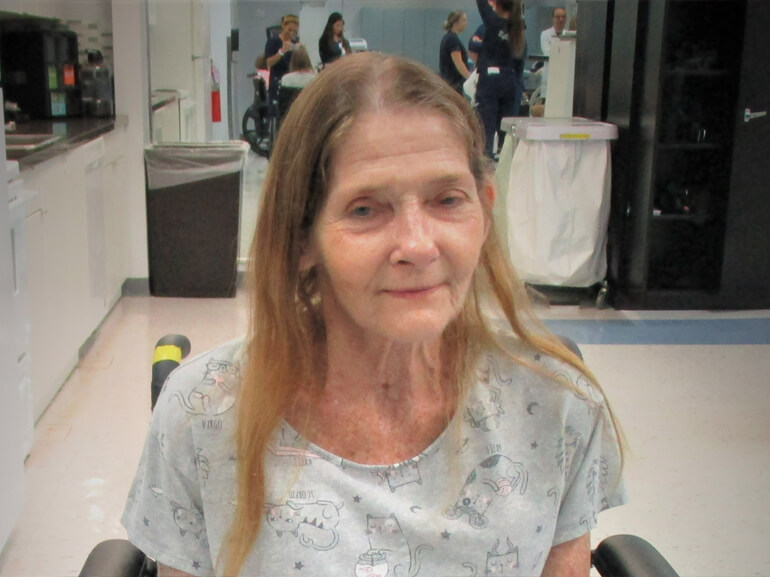Patsy's Story

Patsy Bushea wasn’t prepared for a heart attack, much less multiple heart attacks within six months. Luckily, neighbors were quick to call an ambulance during the first one and when the most serious cardiac event occurred, Patsy’s husband Gari was by her side and immediately called EMTs. When emergency services arrived, Patsy did not have a pulse. It took twenty minutes of CPR to restart her heart – a dangerous amount of time for her brain to be starved of oxygen.
A mom and grandmother, Patsy has a loving family who rushed to Jackson Hospital where she was stabilized and treated. After five and half weeks at Jackson, Patsy’s medical team recommended further healing and recovery at a rehabilitation hospital. For that, Patsy and family chose West Gables Rehabilitation Hospital.
Patsy arrived at West Gables with a tracheostomy – a breathing tube inserted into her neck to help her breathe. She also had a PEG tube inserted in her stomach to provide nutrition and hydration. Patsy was unable to move or speak and was in a diminished mental state – dependent on others for mobility and daily activities. The West Gables care team assessed Patsy to determine her level of function and create treatment goals.
Although she was initially confused from her ordeal, Patsy slowly became more alert and active, allowing speech therapists to trial her on a Passy Muir speaking valve that allowed her to breath and speak simultaneously. She tolerated the valve for 40 minutes at a time. Her therapists and Gari provided her with emotional support and helped lift her spirits as she became more aware and began
processing her new situation and surroundings. They helped to quell her anxiety, explaining where she was with calming words.
Speech therapists also worked on respiratory muscle training to strengthen Patsy’s lungs. She initially struggled with the exercises but persevered. In order to boost Patsy’s cognition, occupational therapists worked with her basic memory exercises and practiced recall activities. As the tone of Patsy’s voice improved, she was able to communicate with staff and family more effectively. To
help with her memory lapses, Patsy used an orientation board to keep track of facts such as the name of the hospital, the date and the time of day.
Meantime, physical therapists (PT) worked to build Patsy’s overall strength by having her sit with support on the edge of the bed for fifteen minutes at a time. She then progressed to gentle leg exercises while seated to strengthen her muscles. As her strength increased, Patsy was less reliant on supplemental oxygen and was able to stand for a minute with help. She also began practicing
transferring from the bed to a standing position with the support of an assistive device.
With occupational therapy (OT), Patsy worked on hand strengthening exercises to better perform activities of daily living such as brushing her hair and her teeth. Patsy received grooming
and beauty care as part of her treatment to engage her in her previous leisure activities and make her feel more like herself. OT worked to increase Patsy’s independence in using the restroom, dressing and grooming.
During this time, Patsy met with a hospital psychologist to help with the emotional aspects of adapting to her major life change. Recreational therapists also worked with Patsy to boost her mood and self-esteem, further addressing her psychological and social needs. She spent time outdoors in the garden playing cognitive games and listening to her favorite music. Interactive
tablet games and virtual reality technology helped improve her memory and cognition, which boosted her spirits. The recreational therapy team even helped celebrate Patsy and Gari’s 48th wedding anniversary by assisting Patsy in writing a card and decorating her room.
Patsy’s lung strength advanced to allow her to breathe on her own, and her tracheotomy was capped. This advancement was very motivating, and Patsy tried more challenging tasks such as standing up and walking longer distances independently, stepping up over curbs, picking up objects off the floor with her rolling walker, navigating obstacles and performing car transfers. Speech
therapists spent time with her during meals and determined she could safely advance her diet to soft and bite-sized foods, allowing the removal of her PEG tube. She was very excited to eat her first sandwich in months. After showing normal oxygen levels with her tracheotomy capped for five days, Patsy was also cleared to have her tracheostomy removed. Therapists involved Gari in
family training and education during this time, ensuring Patsy would be set up for success when she discharged home.
After four weeks of rehabilitation and now able to walk 60 feet with a rolling walker, Patsy was ready to return home. She expressed gratitude to her therapy team and the entire hospital staff who supported and guided her through her challenges. Her advice to others on a recovery journey: “Stay positive and believe in yourself! ”